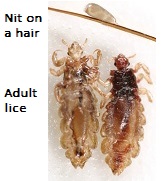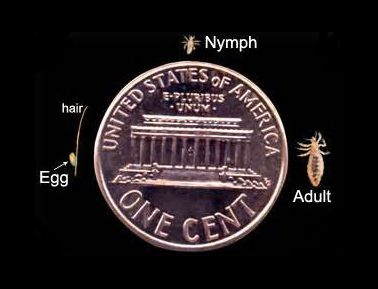Q. When did head lice start to bug the human race?
A. Head lice have been around as long as man has.
Q. Where do lice come from?
A. Head lice come from other head lice. They hatch from eggs (nits) laid by adult female head lice.

Q. What are head lice and what do they look like?
A. Head lice are six legged, wingless parasitic insects that live on human blood and live on human heads. A head louse is small, but visible to the human eye – approximately the size of a sesame seed. They vary in color, from white to gray to reddish-brown, depending on how mature they are (adult or newly hatched nymphs) and how recently they have eaten.
Q. What are the signs to look for if my child (or I) has head lice?
A. First, if you have head lice, you may experience a tickling/crawling sensation or itching on your scalp, particularly around the ears or at the nape of the neck. Head lice feed on human blood and it is the saliva they leave behind after feeding that can cause your head to itch. Not everyone is allergic to the saliva, so you could have head lice and never itch at all.

Q. Where do head lice lay their eggs (nits) and what do the eggs look like?
A. Head lice attach their eggs to a hair shaft, usually closer to the scalp, using a very sticky glue-like substance. Nits are can be white to light grey in color and are very small – approximately the size of a knot in thread.
Q. How many eggs can a single head louse produce? And how long do they take to hatch?
A. Adult female head lice can lay up to 100 eggs over their 30 day lifespan. It takes 7-11 days for lice eggs to hatch and become nymphs (immature lice). In 7-10 days, the nymph matures to an adult, and after another day, the adult female begins laying eggs.
Q. How does someone get head lice?
A. Head lice are contracted by head-to-head contact with an infested person or through contact with that person's belongings.
Q. Do head lice fly?
A. No, head lice do not fly, hop, or jump; they can only crawl, so direct contact with an infested person’s head or personal items (hats, hair accessories, scarves, helmets, backpacks, pillows, bedding, etc.) is the only way to contract head lice.
Q. Can I get (or give) head lice from my dog or cat?
A. No, pets don’t transmit head lice to people, nor can they carry head lice. Head lice are parasites that strictly feed on human blood.
Q. How long do head lice live?
A. Head lice can live on a human head approximately 30 days. They can only survive away from a human head for up to 2 days.
Q. I have heard about super lice. What are they and how are they different from regular head lice?
A. “Super lice” is the term given to head lice that are resistant to traditional over-the-counter lice treatments (pesticides such as pyrethrin and permethrin). They have genetically mutated over the past 20 years or so, and have become virtually unaffected by many head lice treatments. They are indistinguishable from lice that are vulnerable to pyrethroids.
Q. Who can get head lice?
A. Anyone of any age can get head lice, but it affects children from preschool age up to 11 years old (and their families) the most, as they are more likely to have head-to-head contact.
Q. Can you get head lice even if you are clean?
A. Yes. While it is a common belief that lice are only found on people who don’t bathe regularly, this is only a myth. Head lice actually prefer clean, healthy heads since it is easier for them to attach their nits to a clean hair shaft.
Q. How do you get rid of head lice?
A. Live head lice can be treated with shampoos, conditioners and other treatments containing pesticides. Be sure to use those that are safe and non-toxic* for human use. There are all-natural pesticides that are effective in getting rid of live head lice, in conjunction systematically combing out the hair one small section at a time, using a fine-toothed metal comb. Follow the directions on the treatments’ package. Be sure to wipe the comb with each pass from scalp to ends of hair. Once a section is free of lice, move on to the next until the entire head is clear. The combing procedure should be repeated daily for 10 days (incubation period) to ensure there are no nits left behind.
* Never use products containing the pesticide Lindane. It is a neurotoxin and has been determined to cause cancer.
Q. Do I need to throw away anything or fumigate to get rid of lice in my home?
A. No, since head lice must have a human host to survive, getting rid of brushes, recently worn clothing, bedding or stuffed animals is not necessary. Washing at 130 degrees or dry cleaning will eliminate live lice and nits. You can vacuum upholstered furniture and isolate and/or bag items than cannot be washed, but this may not be necessary since any lice crawling in your home will die in less than 48 hours. Fogging and/or spraying insecticide are ineffective and can expose your family unnecessarily to toxins.You can treat with a fabric spray after vacuuming, to repel head lice going forward.
Q. Can you get head lice more than once?
A. Unfortunately, yes. Head lice infestations can affect a person an unlimited number of times. Eliminating all live head lice and removing all nits is the first step to a lice-free existence. If any nits remain on the head (and hatch), you still have head lice. Prevention is the best means of avoiding future head lice infestations. Regular head checks, avoiding head-to-head contact and sharing personal items with others, as well as using non-toxic lice repellent products daily are your best defense.
Q. Are head lice dangerous?
A. No, head lice are considered more of a nuisance than a medical or health hazard. Head lice do not carry disease, but it is possible for the itching to cause excessive scratching that can lead to a secondary skin infection if left untreated.



